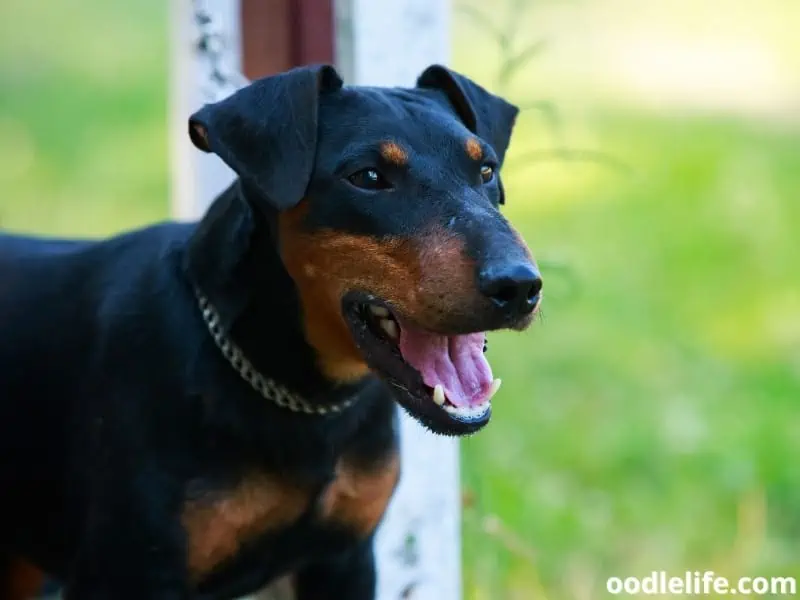My Old Dog Just Stands and Stares at Me
You’re lounging around the house and suddenly feel the unnerving power of an intense stare. You turn around and there’s your senior dog just standing there in the middle of the room with eyes boring into the back of your head.
Yikes! What gives? Why is your dog suddenly staring at you more intently and more frequently?

Don’t fret. You’re not alone. There are several reasons why dogs up their stare game, especially when they get older. Some of these are harmless but some can mean something else.
In this blog post, we’ll look at all the possible reasons why you often catch your dog freakily standing and staring at you. Once you nail down the reason, you can address the behavior.
1. Your Dog Is Showing Affection
One of the simplest reasons is they’re merely just showing affection. Dogs, especially old dogs who have been with you for a long time, can have a wonderful bond with their owner. Just looking at you and having you look back can release the oxytocin hormone.

Oxytocin is a feel-good hormone that is released when you are looking at something you love. This is how you can maintain a close emotional bond between you and your do, which is why you should also make eye contact back to show reciprocal affection.
They often act this way when they’re more relaxed, so look for signs of relaxed behavior and try to maintain eye contact periodically throughout the day.
If the reason they’re looking at you is just affection, they will follow this up with nosing, nuzzling, or coming near you to get attention. If they don’t do this, there might be a different reason why they’re staring.
However, if the eye contact is from an unknown dog or if your dog is displaying nervous or anxious body language, be careful! Prolonged eye contact with an unknown dog can be misconstrued as a challenge.
2. Your Dog Wants Something
The other reason they may be staring at you is that they want something. When they are looking at you with bigger eyes and raising their middle brow, there’s a big chance they are trying to get something from you, especially if you are eating at the dinner table!

Your old dog may also have gotten used to getting treats and snacks during their training and playful time with you. When they stare at you alertly and watchfully during these times, they likely want a treat!
Look for a tilted head, larger eyes, and raised brows that might also accompany some vocalization like a soft whine. If you notice all these telltale signs, chances are they are being greedy little beggars!
3. Your Dog Is Communicating with You
If your dog is not responding with treats or cuddles, there’s also a possibility that they are trying to tell you something. If your old dog is used to a certain schedule, such as a potty break, this staring might be a gentle reminder that it is time to go out.

They could also be communicating their feelings. If they’re standing stiffly and in a defensive position while staring, this is a sign of resource guarding or negative feelings toward you.
Try to recognize their behavior and take into account their habits and schedule. If your dog is communicating this way, then there might be some inconsistencies with the way you are treating them so this is just a mild reminder for you.
Keep a routine schedule to keep conflicts at bay between you and your old dog. Pooches are creatures of habit and old dogs will have hard habits to break. Any straying from their routine might have them confused and anxious.
4. Escalation of Stress
This isn’t a good one. Your old dog might be staring because he is under stress, and if left unchecked, it could escalate into aggression.

Your old dog might be feeling stressed and anxious due to several reasons. They can be bored, feel unsafe, in pain, or feel a tad under the weather. They can also be empathizing with you if you’re feeling stressed especially with older dogs who already have a close bond with their owners.
First, remove your dog from the situation or stressor, this could mean taking them to a quieter place. Then just like humans, exercise could help release and reduce their stress levels. If the stress is a by-product of yours, then that’s another good reason for you both to get moving outside.
Take them for a walk or a hike periodically for the sake of your and your dog’s mental health. Do some light obedience training so that your dog has a chance to be mentally stimulated.
If your old dog has enough exercise, you can also get some interactive toys like treat dispensing balls for them to amuse themselves at home.
5. Your Dog Has A Cognitive Disorder
The problem could also be medical and not behavioral. The bad news for owners of old dogs is that this standing and staring blankly also be a sign of Canine Cognitive Disorders or CDD. This condition is also called Canine Dementia, and it occurs fairly often in old dogs.

Just like humans, dogs can show signs of senility as they grow older. Around 28% of dogs who are aged 11 are diagnosed as having CDD. The percentage only gets worse as the dog ages, but sadly lots of dogs go undiagnosed due to the tricky symptoms.
You’ll need to watch your dog carefully, especially when they approach their golden years. The symptoms you should look out for are disorientation, change in behavior, change in sleeping patterns, and also forgetting their training rules and commands.
If they are standing and staring at you, they could be displaying disorientation and forgetting what they are doing there, so they are simply observing again and trying to suss out the situation.
It’s tricky to properly diagnose this condition because sometimes they don’t exhibit all the symptoms. If you suspect they might be experiencing this issue, take them to the vet to get a proper diagnosis.
6. Focal Point Seizures
You might think that a seizure means foaming at the mouth, shaking, and collapsing, but actually, a condition called a focal point seizure can cause your dog to just stand and stare without responding.

As your dog grows older, it may experience several health issues and focal point seizures can be one of them. It’s a form of dog epilepsy due to brain injury or lesions and can manifest itself in abnormal psychomotor behavior like facial or limb twitches and chewing.
The cause can be blunt trauma to the head or genetic. Think about whether your dog could have hurt its head lately and if you think they have this condition, try calling their name or giving them a treat.
If they react immediately, then they might be just showing affection or asking for treats. If they are unresponsive, then try recording this situation on your phone and call your vet. Show them the video and try to get a proper diagnosis from them.
7. Liver Disease
There’s also a possibility that your old dog is suffering from hepatic encephalopathy due to infection from liver disease. Liver function decreases as dogs age, just like us two-legged people.

The liver usually filters everything toxic to the body such as ammonia, if they’re not filtering this properly due to liver disease, then there’s a chance ammonia will infect the brain, nerves, and spinal cord.
This could lead to dysfunction of the brain and nerves, and your dog will be staring and standing without responding to you.
Try to look for symptoms like seizures and dementia, and try to interact with them to see if they’re acting normally. Look out for other symptoms of liver disease such as shaking, vomiting, low appetite, and lethargy.
Failure to diagnose and treat them early could lead to drastic consequences so make sure you take action as soon as possible if you suspect they’re suffering from liver disease.
8. Diabetes or Loss of Vision
Last but certainly not least, if your aging dog is standing and staring blankly at you, it might be suffering from loss of vision. Loss of vision in dogs is mainly caused by diabetes. Diabetes itself is pretty prevalent in dogs and 1 out of 10 older dogs will experience some degree of it.

And if your dog already has diabetes, there’s a 75% chance that it will experience vision loss. Most of them will develop cataracts, and lose their vision six months after their diabetes diagnosis. This loss of vision can be particularly fast, some can be as quick as 48 hours from totally normal to completely blind.
If they do this often, check out their eyes. If the eyes look different or cloudy, that is a sign of cataracts and should be checked immediately by the vet.
Try to avoid exposing your old dog to diabetes by maintaining a healthy nutritious diet and getting them to exercise regularly.
Final Thoughts
Getting old is tough, and older dogs need some extra-special TLC. Be sure to keep a close eye on your aging dog and provide the best medical attention. Take care!